
Guadalajara is a metropolis with all the perks of an urban and modern city, but it started as a settlement to defend territories conquered by the Spaniards in the early 1530s. The name comes directly from the province and city in Spain, and was chosen by settler Cristóbal de Oñate in honour of Nuño Beltrán de Guzmán (born in Guadalajara, Spain in c. 1485), who was at the time the president of the First High Court of the New Spain (the colonies) and governor of the recently established territories of Pánuco and New Galicia.
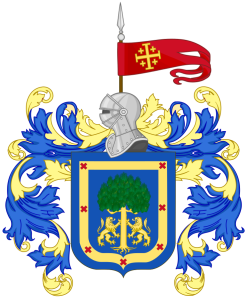
Guadalajara was initially established in Mesa del Centro (now in the Mexican state of Zacatecas), but Guzmán ordered it to be moved from there to Tonalá, pressed by water scarcity, and moved again, to Tlacotán, which got to brandish a coat of arms (see photo) assigned by king Charles V (Charles I of Spain.) Guadalajara finally became stationary after the third change, to its final location, recognized as a more strategic point, and receiving official recognition as a city in February of 1542. Although that site was not populated before the arrival of the Spaniards, there were many native communities in the area, which were constantly abused under Guzmán’s rule, and many were enslaved and shipped to the Caribbean islands. Although Guzmán was deposed and sent back to Spain, the abuse continued, causing revolts over the years that Viceroy Antonio de Mendoza had to settle himself, granting some rights and concessions to these communities; pre-Hispanic arts and crafts were preserved in part because of that, which with further fusion and development during colonial times, are still a source of pride and of employment in the region.
The city of Guadalajara was almost completely destroyed, but the citizens attributed their survival to their faith. Religious orders became important in the city and state, and to this day, Catholicism remains strong amongst the population and engrained in their culture.
This rich and intricated history explains why there are too many Art centres and museums, markets, monuments and interesting churches and landmarks to visit in a single day. However, I had the chance to see some highlights, guided by my niece and her husband, along with my sister and brother in-law.
After a healthy brunch at “La Tetería” (Libertad 1697, Col Americana), our first stop was at El templo expiatorio del sagrado sacramento (Expiatory Temple of the Sacred Sacrament, Calle Manuel López Cotilla 935), an impressive neo-gothic building:
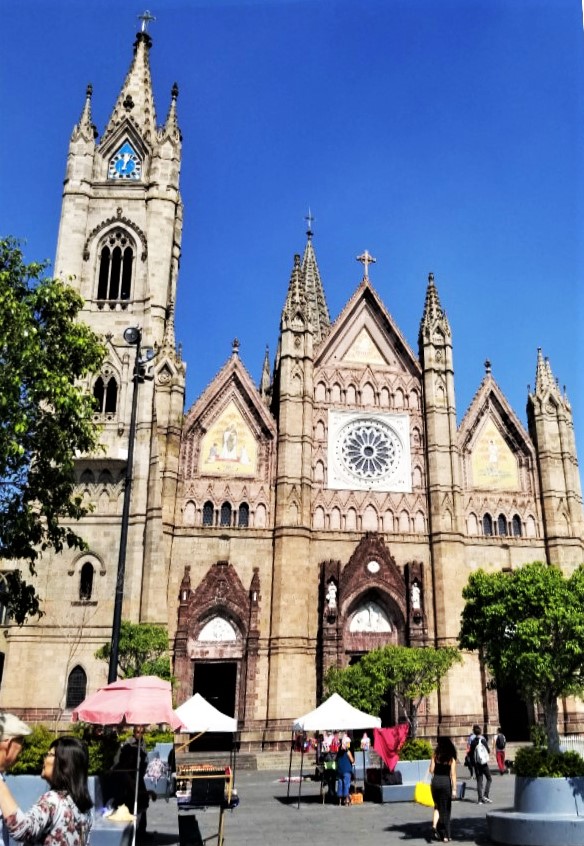
The cornerstone was laid on August 15, 1897 during the dictatorship of Porfirio Díaz and in 1910, construction was interrupted due to the Mexican Revolutionary War. It was not until 1924 that priest José Garibi Rivera took charge; the project received immediate support and donations from the general population, taking another 48 years for it final completion. The façade is embellished with Italian mosaics created in the Vatican’s Mosaic Factory:
The clock was imported from Germany, and every hour, the bells are accompanied by the rotation of twelve figurines representing Jesus’ apostles:
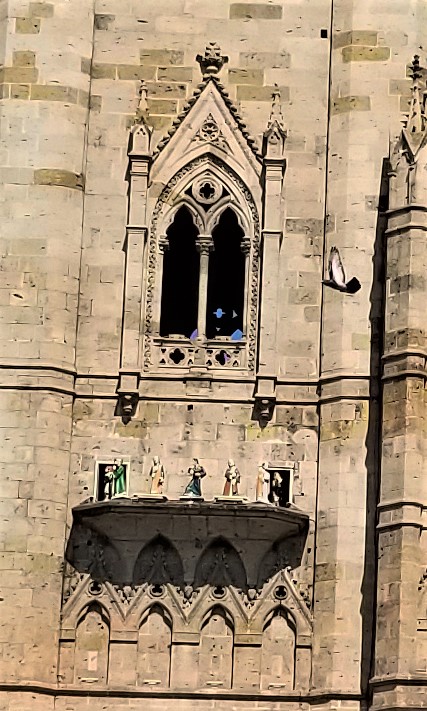
We took our car to a parking garage closer to the downtown area, and arrived at the Catedral de Guadalajara (Av. Fray Antonio Alcalde 10, Zona Centro):
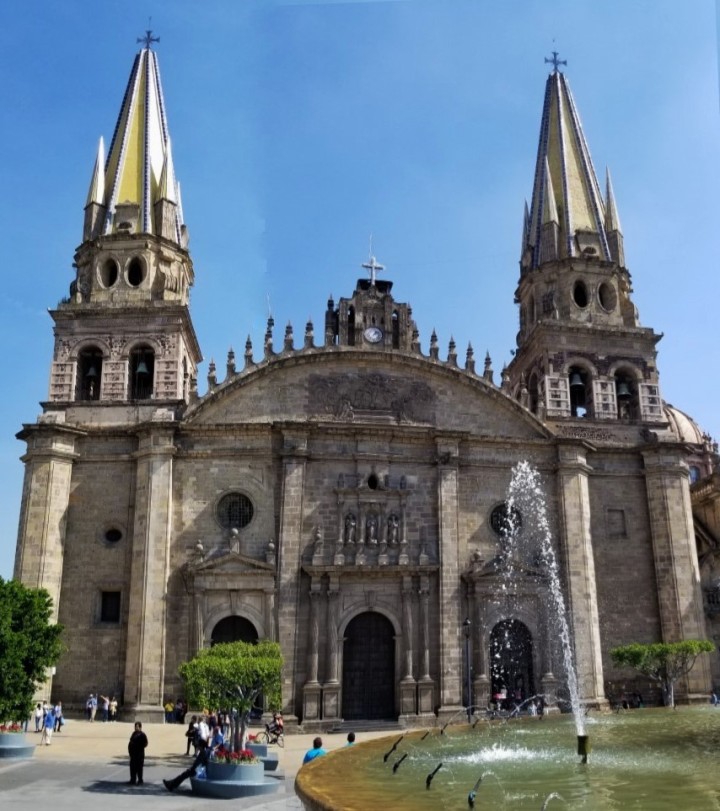
The construction of the church began in 1561 by order of Spanish King Phillip; the project took close to fifty years to completion, and in 1716, it was consecrated as the Cathedral of Guadalajara. Damage throughout the following centuries due to earthquakes and other incidents required full reconstruction of the towers, and other parts of the façade and structure; this has given the building an eclectic look of baroque, gothic and neoclassic motifs, such as the details shown in the photo below:
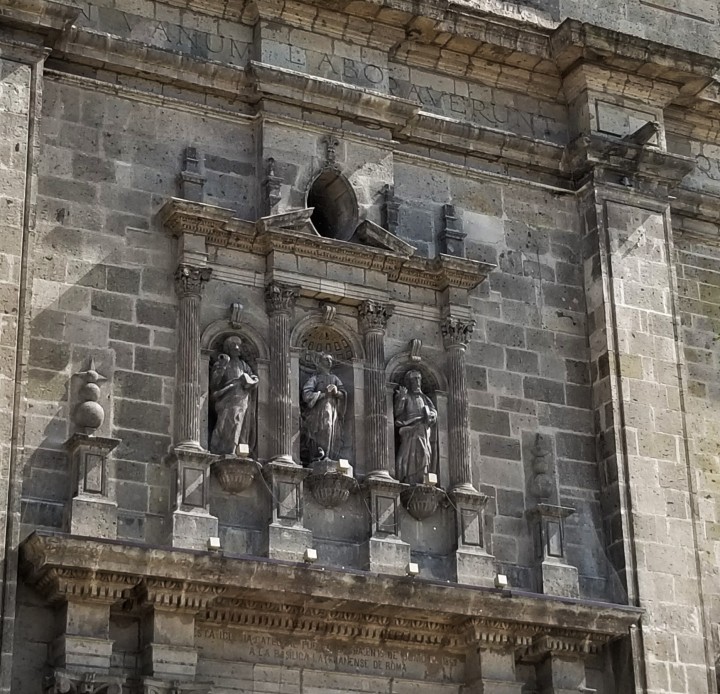
The sanctuary and altar are elaborately decorated and there are several pieces of artistic stained glass:

An interesting sight by the side of the Guadalajara Square across from the cathedral was a line-up of calandrias, old-fashioned horse-drawn carriages, which seemed to be missing, well, the horse! Kudos to the government of Guadalajara for the decision to retire the use of animals in 2017, gradually refurbishing the carriages with electric engines:
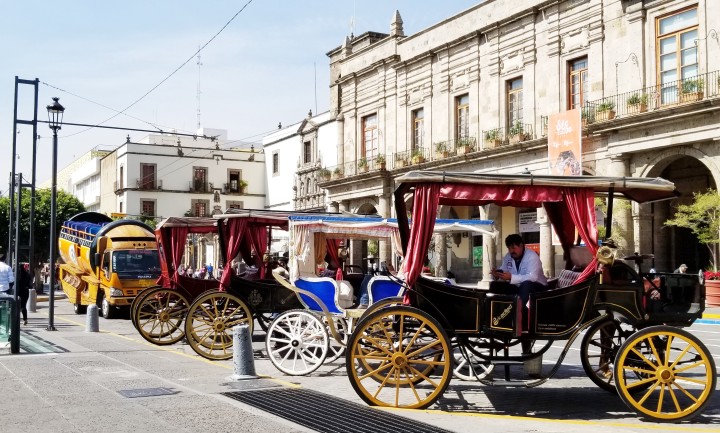
Next to the cathedral, the State’s Government Palace sits behind the Plaza de armas (Armory Square)
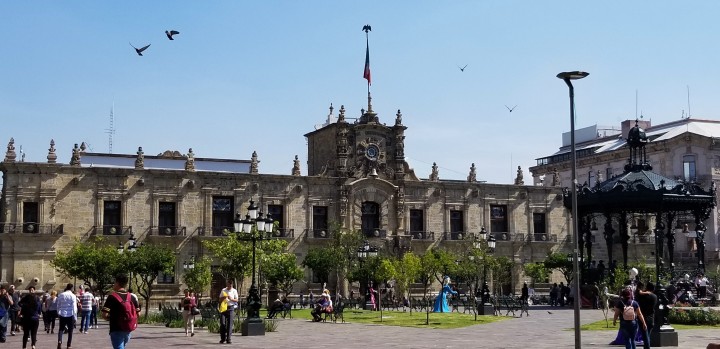
We continued our walk along Morelos St., one of the corridors of the Historic Centre district, passing along the Degollado Theatre (Fine Arts and concert hall):
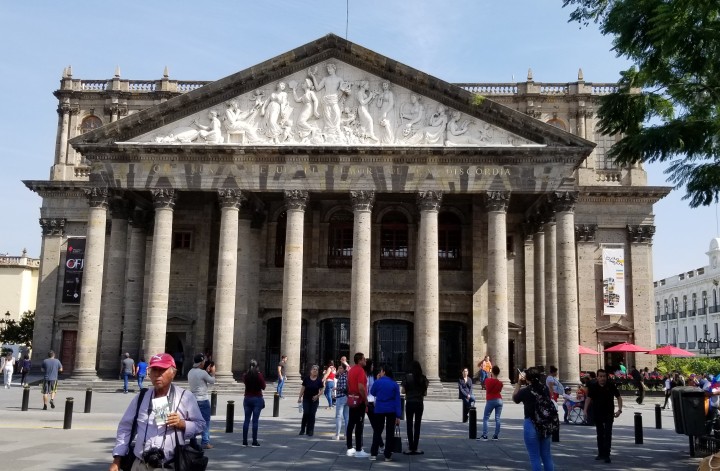
Next, was The Founders Square, with a relief and fountain representing the different characters and ethnicities involved in the foundation and history of Guadalajara (plaque in the photo below, and fountain at the top of the post):
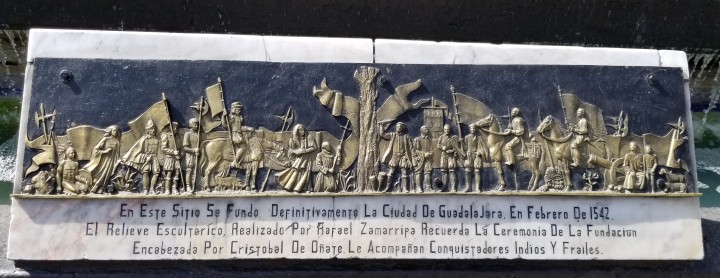
Continuing along the pedestrian corridor Paseo Hospicio (named after the former Cabañas Hospice, seen at the end of the lane), we encountered the Fountain of the Mischievous Children:
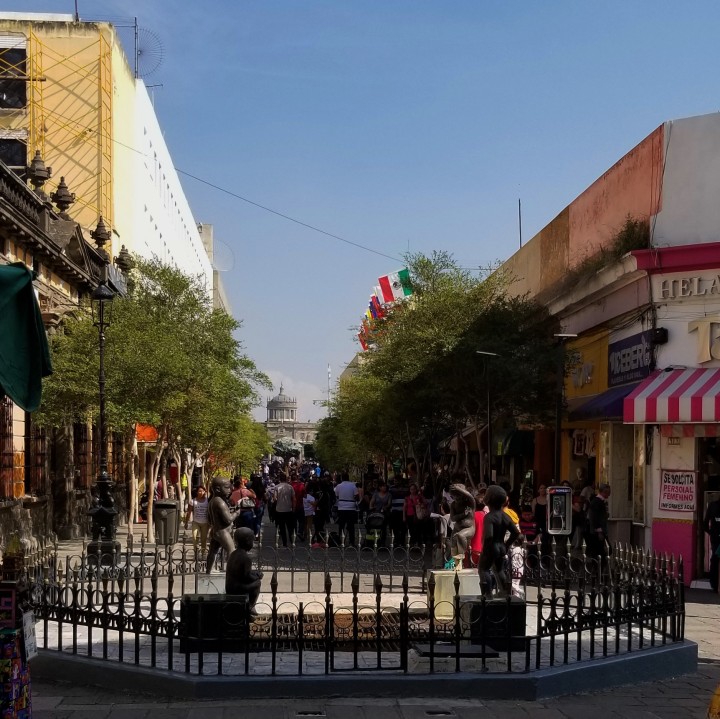
The busy lane was filled with local families and tourists alike, as well as many stands offering street food and beverages, such as the tejuinos with lime sorbet (fermented corn based) and rusas (citrus and spicy), claimed as “100% tapatíos” (100% from Guadalajara):
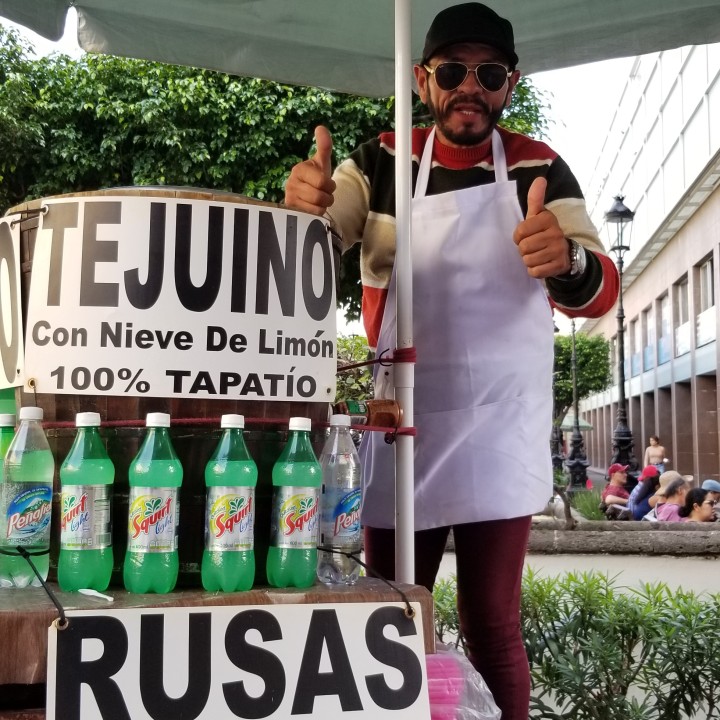
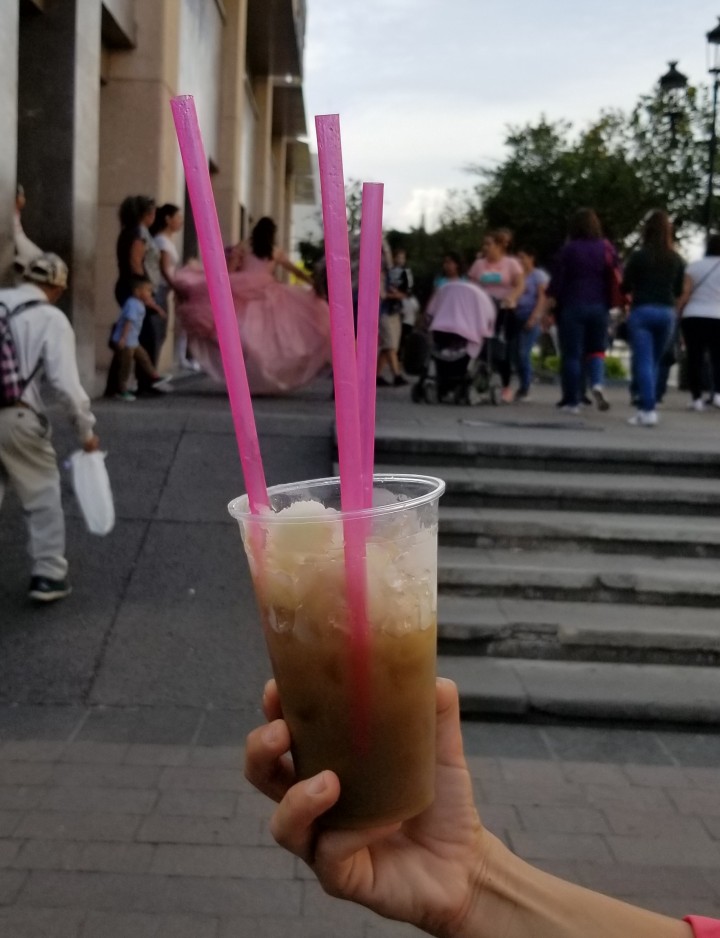
We shared a refreshing tejuino with lime sorbet (photo above) and continued on the same lane, to the statue of the lions of Guadalajara’s Coat of Arms:
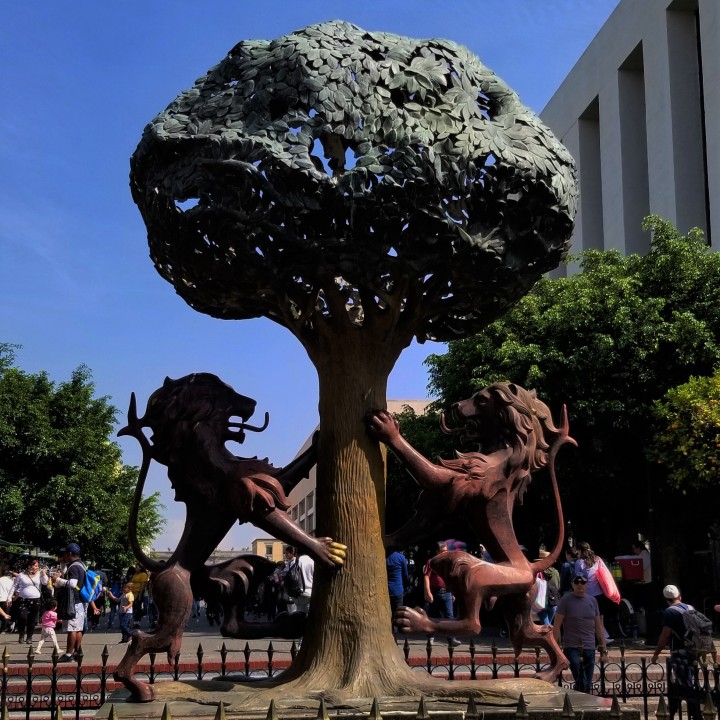
And the beautiful fountains leading to the Cabañas Cultural Institute, in the building of the former hospice:

This impressive facility was founded as an orphanage, hospital and almshouse by the Bishop of Guadalajara, named after Juan Ruiz de Cabañas, see of Guadalajara. The construction of the whole complex was completed in 1829, and with only a brief interruption, it continued serving in its original capacities until 1980, when it became the Cabañas Cultural Institute, housing affiliated schools of Arts and Crafts:

What a delightful way to share a Saturday morning with family! Thank you so much to my adorable niece and her husband, and my sister and brother in-law for sharing this special day, and showing me some of the cultural jewels of Guadalajara.

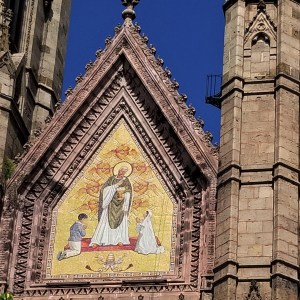








That 16th century cathedral is amazing! It must be one of the oldest in North America.
LikeLike
I imagine so, along with Mexico City’s and maybe Merida in the Yucatan peninsula, I am guessing
LikeLiked by 1 person
Another wonderful virtual vaca for me. Thank you for sharing your adventure, Irene!
LikeLike
Thank you for coming along, MsJadeLi!
LikeLiked by 1 person
Your wonderful stores and history of Mexico with your recipes and photographs make me want to go there so much. Perhaps one day. I shall continue to be a arm chair traveler through you delicious and picturesque blog.
LikeLike
So happy you’d tagged along, thank you, Tazzie!
LikeLiked by 1 person
Fascinating post about the Guadalajara. I’ve been to Mexico many times but almost always to the Yucatan.
LikeLike
There are so many different interesting regions in Mexico. Thank you for your kind comment!
LikeLike
You can find awesome places with great views in Guadalajara! It has its secret places
LikeLiked by 1 person